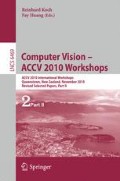Abstract
I hope to start from one question. “Is the eigenface[1] a subspace method?”
Answer is weakly YES and strongly NO. In wide meaning in Subspace method of pattern recognition is that uses subspace. In this meaning the answer is YES. However in narrow meaning the term “Subspace method” means pattern recognition techniques that represent class featuring information with subspace of original feature space[2]. The eigenface subspace represent common feature of trained faces, that is differ from class information. Thus in this meaning the answer is NO.
For understanding the term of “Subspace method”, we shall trace back to a Subspace method root. In this article I try to clarify the meaning of Subspace method through the historical study. To this goal we trace histories of Subspace methods from their birth at 1960s to 21c. We studied the history both side of theory and applications, because sometimes new theory is inspired by new application and new theory extend applicability of Subspace methods.
The history of Subspace method is classified in three epochs.
First epoch is the birth of Subspace methods, from ’60th to ’70th. Subspace method was originated by two Japanese researcher Prof. Taizo Iijima and Prof. Satoshi Watanabe independently. Prof. Iijima try to formulate an observation theory of object that include scale space methods[4]. Prof. Watanabe started from the information theory and the theory of probabilistic logics[5]. Interestingly they reached same goal from other start points. Their results are “categories or class information is represented by subspaces”.
Second epoch is the age of the application to character recognition and discriminative Subspace methods. Main issue of pattern recognition research in this age is character recognition[6]. Especially Japanese Kanji recognition problem was very important industrial problem in Japan. For obtaining high recognition accuracy, many discriminative Subspace methods were proposed[7]
Third epoch was starting from Yamaguch et. al [8]. They demonstrate the effectiveness of mutual Subspace method for object recognition problem. From their paper, Subspace method is defined important technology of object recognition problem, and many improvement and extension were proposing[9,10,11,12]. Many other applications were proposed[13] in this epoch.
From this historical study, we try to discuss current status and future issue of Subspace method.
Access this chapter
Tax calculation will be finalised at checkout
Purchases are for personal use only
References
Turk, M., Pentland, A.: Eigenface for recognition. Journal of Cognitive Neuroscience 3(1), 71–86 (1991)
Watanabe, S.: Knowing and Guessing. A Quantative study of Inference and Information. John Wilei and Sons, West Sussex (1969)
Watanabe, S.: Karhunen - Loeve expansion and factor analysis - Theoretical remarks and application. In: Proc. 4th Prague Conf. Information Theory (1965)
Iijima, T.: Theory of pattern recognition, Morikita (1989) (in Japanese)
Watanabe, S., Lambert, P.F., Kulikowski, C.A., Buxton, J.L., Walker, R.: gEvaluation and selection of variables in pattern recognition. In: Tou, J. (ed.), h Computer and Information Sciences. vol. 2, pp. 91–122. Academic Press, New York (1967)
Mori, S., Suen, C.Y., Yamamoto, K.: Historical Review of OCR Research and Development. Proceedings of the IEEE 80(7), 1029–1058 (1992)
Oja, E.: Subspace Methods of Pattern Recognition. Research Studies Press (1983)
Yamaguchi, O., Fukui, K., Maeda, K.: Face recognition using temporal image sequence. In: Proc. of IEEE 4th Int’l. Conf. on Face and Gesture Recognition, pp. 318–323 (1998)
Fukui, K., Stenger, B., Yamaguchi, O.: A framework for 3D object recognition using the kernel constrained mutual subspace method. In: Proceedings of Asian Conference on Computer Vision, pp. 315–324 (2006)
Fukui, K., Yamaguchi, O.: The kernel orthogonal mutual subspace method and its application to 3D object recognition. In: Yagi, Y., Kang, S.B., Kweon, I.S., Zha, H. (eds.) ACCV 2007, Part II. LNCS, vol. 4844, pp. 467–476. Springer, Heidelberg (2007)
Kim, T., Kittler, J., Cipolla, R.: Discriminative learning and recognition of image set classes using canonical correlations. IEEE Trans. PAMI 29(6), 1005–1018 (2007)
Sakano, H., Mukawa, N.: Kernel mutual subspace method for robust facial image recognition. In: Proc. of 4th Int’l. Conf. on Knowledge based Engineering System, vol. 1, pp. 245–248, Brighton, Sakano, H., Mukawa, N., Nakamura, T. (eds.) Kernel mutual subspace method and its application for object recognition. Electronics and Communications in Japan. vol. E88(6), pp. 45–53 (Jounal paper version) (2000)
Bagan, H., Takeuchi, W., Yamagata, Y., Wang, X., Yasuoka, Y.: gExtended Averaged Learning Subspace Method for Hyperspectral Data Classificationh. Sensors 9(6), 4247–4270 (2009)
Author information
Authors and Affiliations
Editor information
Editors and Affiliations
Rights and permissions
Copyright information
© 2011 Springer-Verlag Berlin Heidelberg
About this paper
Cite this paper
Sakano, H. (2011). A Brief History of the Subspace Methods. In: Koch, R., Huang, F. (eds) Computer Vision – ACCV 2010 Workshops. ACCV 2010. Lecture Notes in Computer Science, vol 6469. Springer, Berlin, Heidelberg. https://doi.org/10.1007/978-3-642-22819-3_44
Download citation
DOI: https://doi.org/10.1007/978-3-642-22819-3_44
Publisher Name: Springer, Berlin, Heidelberg
Print ISBN: 978-3-642-22818-6
Online ISBN: 978-3-642-22819-3
eBook Packages: Computer ScienceComputer Science (R0)

